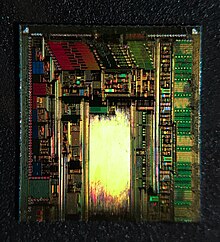"Up-sequencing" and "Down-sequencing" redirect here. For unrelated but similar-sounding terms, see Up-cycling and Down-cycling.


Power management integrated circuits (power management ICs or PMICs or PMU as unit) are integrated circuits for power management. Although PMIC refers to a wide range of chips (or modules in system-on-a-chip devices), most include several DC/DC converters or their control part. A PMIC is often included in battery-operated devices (such as mobile phone, portable media players) and embedded devices (such as routers) to decrease the amount of space required.


Overview
The term PMIC refers to a class of integrated circuits that perform various functions related to power requirements. A PMIC may have one or more of the following functions:
- DC-to-DC conversion
- Battery charging
- Power-source selection
- Voltage scaling
- Power sequencing
- Miscellaneous functions
Power management ICs are solid state devices that control the flow and direction of electrical power. Many electrical devices use multiple internal voltages (e.g., 5 V, 3.3 V, 1.8 V, etc.) and sources of external power (e.g., wall outlet, battery, etc.), meaning that the power design of the device has multiple requirements for operation. A PMIC can refer to any chip that is an individual power related function, but generally refer to ICs that incorporate more than one function such as different power conversions and power controls such as voltage supervision and undervoltage protection. By incorporating these functions into one IC, a number of improvements to the overall design can be made such as better conversion efficiency, smaller solution size, and better heat dissipation.
Features
A PMIC may include battery management, voltage regulation, and charging functions. It may include a DC to DC converter to allow dynamic voltage scaling. Some models are known to feature up to 95% power conversion efficiency. Some models integrate with dynamic frequency scaling in a combination known as DVFS (dynamic voltage and frequency scaling).
It may be manufactured using BiCMOS process. They may come as QFN package. Some models feature I²C or SPI serial bus communications interface for I/O.
Some models feature a low-dropout regulator (LDO), and a real-time clock (RTC) co-operating with a backup battery.
A PMIC can use pulse-frequency modulation (PFM) and pulse-width modulation (PWM). It can use switching amplifier (Class-D electronic amplifier).
IC manufacturers
Some of many manufacturers of PMICs:
- Analog Devices
- Cypress Semiconductor
- Exar
- Infineon Technologies AG
- Intel
- Intersil
- IXYS
- Marvell Semiconductor
- MediaTek
- Monolithic Power Systems
- Nordic Semiconductor
- NXP Semiconductors
- ON Semiconductor
- Qualcomm
- Renesas Electronics
- Ricoh Electronic Devices
- Rohm Semiconductor
- Samsung Semiconductor
- Silergy
- STMicroelectronics
- Texas Instruments
See also
- Power cycle (power supplies)
- Power electronics
- Power management unit (PMU)
- Power ramp
- Quick charge
- System basis chip (SBC)
- System management controller (SMC)
References
- "Power Management | Analog Devices".
- "Power Management Guide" (PDF) (R ed.). Texas Instruments. 2018. SLVT145. Retrieved 15 January 2019.